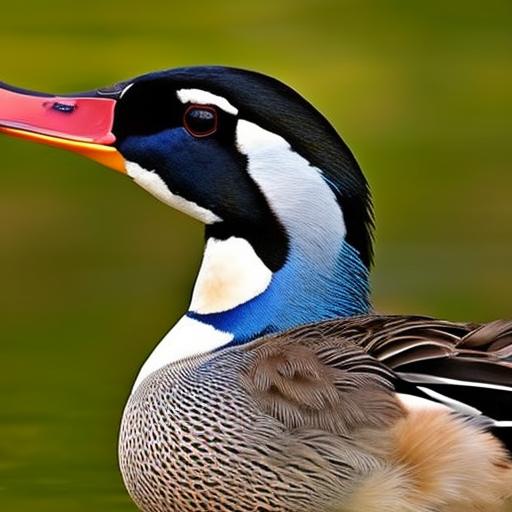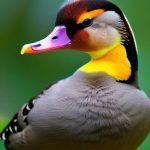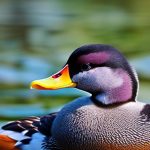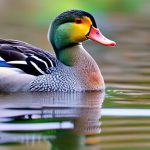Ducks have been domesticated for thousands of years, with evidence of their existence dating back to ancient Egypt and China. They were initially kept for their meat and eggs, but over time, they have become popular as pets and for exhibition purposes as well. Duck breeds play a crucial role in agriculture and hobby farming, providing a sustainable source of food and income for many people around the world.
There are numerous different types of duck breeds, each with its own unique characteristics and traits. Some breeds are known for their excellent egg-laying abilities, while others are prized for their meat production. Additionally, there are ornamental duck breeds that are bred for their beauty and aesthetic appeal. Whether you are looking to raise ducks for their eggs, meat, or simply as pets, there is a breed out there that will suit your needs.
Key Takeaways
- There are many different breeds of ducks, each with their own unique characteristics and purposes.
- Domestic duck breeds are the most common and come in a variety of sizes and colors.
- The most popular duck breeds include the Pekin, Muscovy, and Rouen.
- Rare and exotic duck breeds, such as the Mandarin and Cayuga, are fascinating to learn about.
- Waterfowl breeds are adaptable to different environments, while ornamental breeds are both beautiful and functional.
Domestic Duck Breeds: A Comprehensive Overview
Domestic duck breeds come in a wide variety of sizes, colors, and patterns. They have been selectively bred over generations to enhance certain traits such as egg-laying ability, meat production, or ornamental features. Some popular domestic duck breeds include the Pekin duck, Muscovy duck, Khaki Campbell duck, and Rouen duck.
Domestic ducks differ from wild ducks in several ways. Firstly, domestic ducks have been bred to be larger in size compared to their wild counterparts. They also tend to have a more docile temperament and are easier to handle. Domestic ducks are also more likely to lay eggs year-round, whereas wild ducks typically only lay eggs during the breeding season.
The Most Popular Duck Breeds: A Closer Look
1. Pekin Duck: The Pekin duck is one of the most popular duck breeds worldwide. It is known for its large size, white feathers, and orange bill. Pekin ducks are excellent egg layers and are also commonly raised for meat production. They have a calm and friendly temperament, making them suitable for both backyard and commercial farming.
2. Muscovy Duck: The Muscovy duck is a unique breed known for its distinctive red facial caruncles and large size. Unlike other duck breeds, Muscovy ducks are not as reliant on water and can thrive in drier environments. They are excellent foragers and are often raised for their meat, which is lean and flavorful.
3. Khaki Campbell Duck: The Khaki Campbell duck is a popular breed known for its excellent egg-laying abilities. They are prolific layers, capable of producing up to 300 eggs per year. Khaki Campbell ducks have a khaki-colored plumage and a friendly temperament, making them a favorite among hobby farmers.
4. Rouen Duck: The Rouen duck is a large breed with beautiful plumage that resembles that of wild Mallard ducks. They are primarily raised for meat production but can also lay a decent number of eggs. Rouen ducks have a calm and gentle nature, making them suitable for both backyard and commercial farming.
Rare and Exotic Duck Breeds: A Fascinating Collection
While the most popular duck breeds are well-known, there are also rare and exotic duck breeds that are less commonly seen. These breeds often have unique physical characteristics and traits that make them stand out from the crowd.
One example of a rare duck breed is the Indian Runner duck. This breed is known for its upright posture and distinctive running gait, hence the name “Runner.” Indian Runner ducks come in various colors, including white, fawn, black, and chocolate. They are primarily kept for their egg-laying abilities, as they can lay up to 200 eggs per year.
Another rare duck breed is the Crested duck, which is characterized by its prominent crest on top of its head. Crested ducks come in various colors and patterns, including white, black, and blue. They are primarily kept for exhibition purposes due to their unique appearance.
Raising rare and exotic duck breeds can be a rewarding experience, but it also comes with its challenges. These breeds may require specialized care and attention, and finding breeders or hatcheries that offer them can be more difficult compared to popular breeds. However, for those looking to add something unique and different to their flock, rare and exotic duck breeds can be a great choice.
Waterfowl Breeds: Ducks for Every Environment
Waterfowl breeds are specifically adapted to aquatic environments and are well-suited for living near bodies of water such as ponds, lakes, or rivers. These breeds have certain physical characteristics that enable them to swim and dive effectively.
One example of a waterfowl breed is the Mallard duck, which is the ancestor of many domestic duck breeds. Mallards have a green head, brown body, and distinctive blue wing patches. They are excellent swimmers and divers, making them well-suited for living in wetland habitats.
Another waterfowl breed is the Muscovy duck, which has already been mentioned as a domestic duck breed. Muscovy ducks have strong claws on their feet that enable them to perch on trees or other elevated surfaces near water. This adaptation allows them to escape predators or find nesting sites away from the water.
When raising waterfowl breeds, it is important to provide them with access to clean and fresh water. Ducks rely on water for grooming, feeding, and maintaining their overall health. Additionally, water quality plays a crucial role in preventing diseases and ensuring the well-being of the ducks.
Ornamental Duck Breeds: Beauty and Functionality
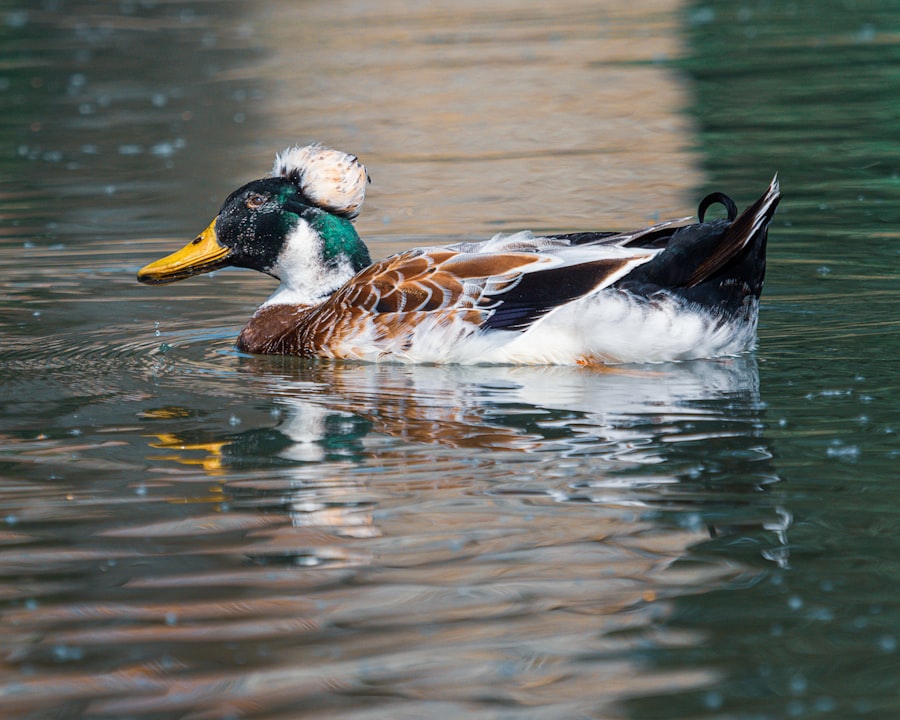
Ornamental duck breeds are bred primarily for their aesthetic appeal rather than their practical uses such as egg-laying or meat production. These breeds often have unique and eye-catching plumage patterns, colors, or crests that make them stand out.
One example of an ornamental duck breed is the Mandarin duck, which is native to East Asia. Mandarin ducks are known for their vibrant and intricate plumage, with males having a combination of orange, green, and blue feathers. They are often kept in aviaries or ponds for their beauty and are not typically raised for meat or eggs.
Another ornamental duck breed is the Call duck, which is one of the smallest domestic duck breeds. Call ducks come in various colors and patterns, including white, gray, and black. They are known for their distinctive quacking sound and are often kept as pets or for exhibition purposes.
There are also dual-purpose breeds that are both ornamental and functional. An example of this is the Silver Appleyard duck, which has a striking plumage pattern of silver and white. Silver Appleyard ducks are known for their excellent egg-laying abilities as well as their meat production. They have a friendly temperament and are suitable for both backyard and commercial farming.
Egg-Laying Duck Breeds: High-Quality and Sustainable
For those looking to raise ducks primarily for egg production, there are several breeds that excel in this area. These breeds are known for their high-quality eggs and consistent laying abilities.
One of the best egg-laying duck breeds is the Khaki Campbell duck, which has already been mentioned as a popular domestic duck breed. Khaki Campbell ducks can lay up to 300 eggs per year, making them one of the most prolific layers among duck breeds. Their eggs have a rich flavor and a high nutritional value.
Another excellent egg-laying breed is the Indian Runner duck. Indian Runner ducks have a slender body shape and an upright posture, which allows them to lay eggs more easily. They can lay up to 200 eggs per year and are known for their excellent foraging abilities.
When raising egg-laying duck breeds, it is important to provide them with a suitable nesting area where they can lay their eggs in peace. Ducks prefer dark and secluded spaces for nesting, so providing them with nesting boxes or shelters will encourage them to lay eggs regularly.
Sustainable egg production practices should also be implemented to ensure the well-being of the ducks and the quality of the eggs. This includes providing a balanced diet, access to clean water, and proper healthcare. Additionally, allowing ducks to free-range and forage for food can help reduce feed costs and promote natural behaviors.
Meat Duck Breeds: Delicious and Nutritious
Duck meat is known for its rich flavor and tender texture, making it a popular choice for many culinary dishes. There are several duck breeds that are specifically bred for meat production, with characteristics that make them well-suited for this purpose.
One of the best meat duck breeds is the Pekin duck, which has already been mentioned as one of the most popular domestic duck breeds. Pekin ducks have a large size and a high meat-to-bone ratio, making them ideal for meat production. Their meat is tender, flavorful, and versatile in cooking.
Another excellent meat duck breed is the Muscovy duck. Muscovy ducks have lean and flavorful meat that is often compared to beef or veal. They have a higher proportion of breast meat compared to other duck breeds, making them a favorite among chefs and food enthusiasts.
When raising meat duck breeds, it is important to provide them with a balanced diet that promotes healthy growth and development. Ducks raised for meat production should have access to high-quality feed that is specifically formulated for their nutritional needs. Additionally, providing ample space for exercise and ensuring proper hygiene in their living environment will contribute to the overall quality of the meat.
Dual-Purpose Duck Breeds: Versatile and Adaptable
For those looking to raise ducks for both egg and meat production, there are several dual-purpose duck breeds that offer the best of both worlds. These breeds are versatile and adaptable, making them suitable for a variety of farming purposes.
One example of a dual-purpose duck breed is the Rouen duck, which has already been mentioned as a popular domestic duck breed. Rouen ducks are known for their large size and flavorful meat, making them suitable for meat production. They can also lay a decent number of eggs, although not as prolific as some other breeds.
Another dual-purpose breed is the Silver Appleyard duck, which has already been mentioned as an ornamental duck breed. Silver Appleyard ducks are known for their excellent egg-laying abilities as well as their meat production. They have a friendly temperament and are suitable for both backyard and commercial farming.
Raising dual-purpose duck breeds requires careful management and planning to ensure optimal results in both egg and meat production. Providing a balanced diet, ample space for exercise, and proper healthcare will contribute to the overall health and productivity of the ducks.
Choosing the Right Duck Breed: Factors to Consider
When choosing a duck breed, there are several factors to consider to ensure that you select the right breed for your specific needs and circumstances.
Climate: Different duck breeds have different temperature tolerances. Some breeds are better suited for colder climates, while others thrive in warmer environments. Consider the climate of your location and choose a breed that can adapt well to the local weather conditions.
Space: Ducks require ample space to roam and exercise. Some breeds are more active and require larger areas to thrive, while others can do well in smaller spaces. Assess the available space you have and choose a breed that is suitable for your specific setup.
Purpose: Determine whether you are raising ducks primarily for eggs, meat, or ornamental purposes. Different breeds excel in different areas, so it is important to choose a breed that aligns with your goals and expectations.
Research: Take the time to research different duck breeds and their specific characteristics. Consider factors such as temperament, egg-laying abilities, meat quality, and overall suitability for your intended purpose. Online resources, books, and local breeders can provide valuable information to help you make an informed decision.
Finding and purchasing duck breeds can be done through various channels. Local breeders, hatcheries, or agricultural fairs are common sources for acquiring ducks. It is important to ensure that the ducks you purchase are healthy and come from reputable sources. Additionally, consider the availability of ongoing support and guidance from the breeder or hatchery to ensure a successful experience in raising your chosen duck breed.
In conclusion, duck breeds play a significant role in agriculture and hobby farming. They provide a sustainable source of food and income for many people around the world. Whether you are looking to raise ducks for their eggs, meat, or simply as pets, there is a breed out there that will suit your needs. By considering factors such as climate, space, purpose, and conducting thorough research, you can choose the right duck breed for your specific circumstances.
If you’re interested in different breeds of ducks and love looking at pictures of them, you’ll definitely want to check out this article on Poultry Wizard. They have a fantastic collection of duck pictures that showcase the beauty and diversity of various duck breeds. From the adorable Mallards to the striking Muscovy ducks, you’ll be captivated by their stunning colors and unique features. So, grab a cup of coffee and click on this link to explore the wonderful world of ducks: https://poultrywizard.com/keeping-chickens/where-to-put-chicken-coop/.
FAQs
What are the different breeds of ducks?
There are over 100 different breeds of ducks, including the popular Pekin, Muscovy, Mallard, and Rouen.
What is the difference between domestic and wild ducks?
Domestic ducks are bred for their meat, eggs, or ornamental purposes, while wild ducks are found in their natural habitats and are not typically kept as pets.
What are some characteristics of different duck breeds?
Different duck breeds have varying physical characteristics, such as size, color, and feather patterns. For example, the Pekin duck is a large, white breed with a yellow bill, while the Muscovy duck has a distinctive red face and is known for its meat.
What are some common uses for ducks?
Ducks are commonly used for their meat and eggs, as well as for hunting and as pets. Some breeds are also used for their down feathers, which are used in pillows and comforters.
What are some interesting facts about ducks?
Ducks are known for their waterproof feathers, which are coated in oil to keep them dry. They also have a unique digestive system that allows them to extract nutrients from their food more efficiently than other birds. Additionally, ducks are social animals and often form close bonds with their mates and other ducks in their flock.
Meet Walter, the feathered-friend fanatic of Florida! Nestled in the sunshine state, Walter struts through life with his feathered companions, clucking his way to happiness. With a coop that’s fancier than a five-star hotel, he’s the Don Juan of the chicken world. When he’s not teaching his hens to do the cha-cha, you’ll find him in a heated debate with his prized rooster, Sir Clucks-a-Lot. Walter’s poultry passion is no yolk; he’s the sunny-side-up guy you never knew you needed in your flock of friends!

